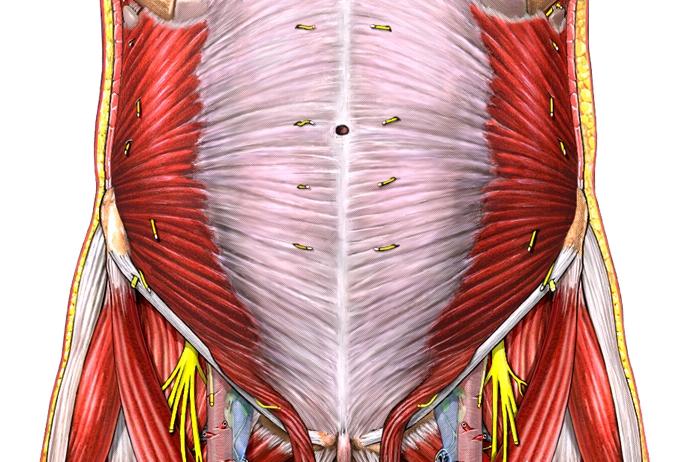The Anatomy of the Abdomen (part 2/4: Internal Obliques)
The internal oblique is just below, or beneath the surface, of the external oblique. The fibers of the internal oblique run perpendicular to the external oblique; this cross-stitching of the muscles give the  oblique a tremendous amount of stability and are extremely useful to the respiratory system in breathing and providing support for the organs while they move with the expansion of the lungs. You can see the difference between the internal and external obliques on the photo to the right; the external oblique is located superficially, or closer to the skin, than the internal oblique.
oblique a tremendous amount of stability and are extremely useful to the respiratory system in breathing and providing support for the organs while they move with the expansion of the lungs. You can see the difference between the internal and external obliques on the photo to the right; the external oblique is located superficially, or closer to the skin, than the internal oblique.
The origin points for the internal obliques are the thoracolumbar fascia along the spine, the front of the hip plate, or iliac crest, and the bottom of the hip plate along the inguinal ligament. The insertion points are the linea alba, the concave vertical centerline of the abdomen and the rib cartilage of ribs 8 through 12. It stitches up the front of the midline up and back, away from the ground. This muscle is very active in the retention of Uddiyana Bandha, though probably less active than the transverse abdominus muscle. The muscle covers the belly from the bottom of the ribs to the sitting bones.
Great ways to activate the internal obliques are with isometric exercises to press the arms against the legs, possibly while lying on the back or standing. The muscle spreads up towards the mid-line, so using the airs to stretch the torso will also help to activate the muscle group. Side plank (Vasisthasana) with your leg lifted, standing back-bends, and locust poses can get these muscles active. Anything where you are reaching up with the arms and a straight spine will activate the torso muscles all the way down to the lower internal obliques. Warrior 3 is a very active pose and is awesome for warming up the sides of the body, as are side angle and half-moon pose. When the body is working in concert, it is most powerful. The breath is the composer.
The internal oblique is a major muscle for moving internal organs on exhalations and making room for the chest cavity to expand. It, combined with the transverse abdominus muscle and diaphragm, are major muscles you feel while you exhale. The muscle has a second major function, which is to move with the external oblique to creation torsion in the spine. when you lift one shoulder and lower the other, you active the internal and external obliques simultaneously. The muscles work in opposition to keep you and your spine upright so that you can stand and more importantly, walk and run.
The Anatomy of the Abdomen (part 2/4: Internal Obliques) Read More »

